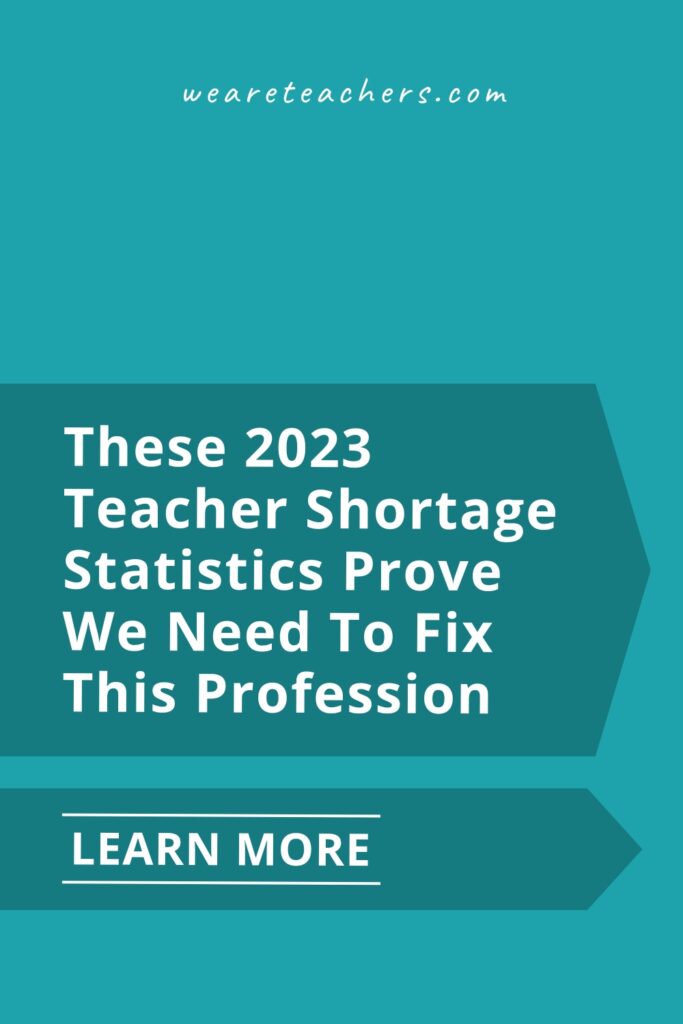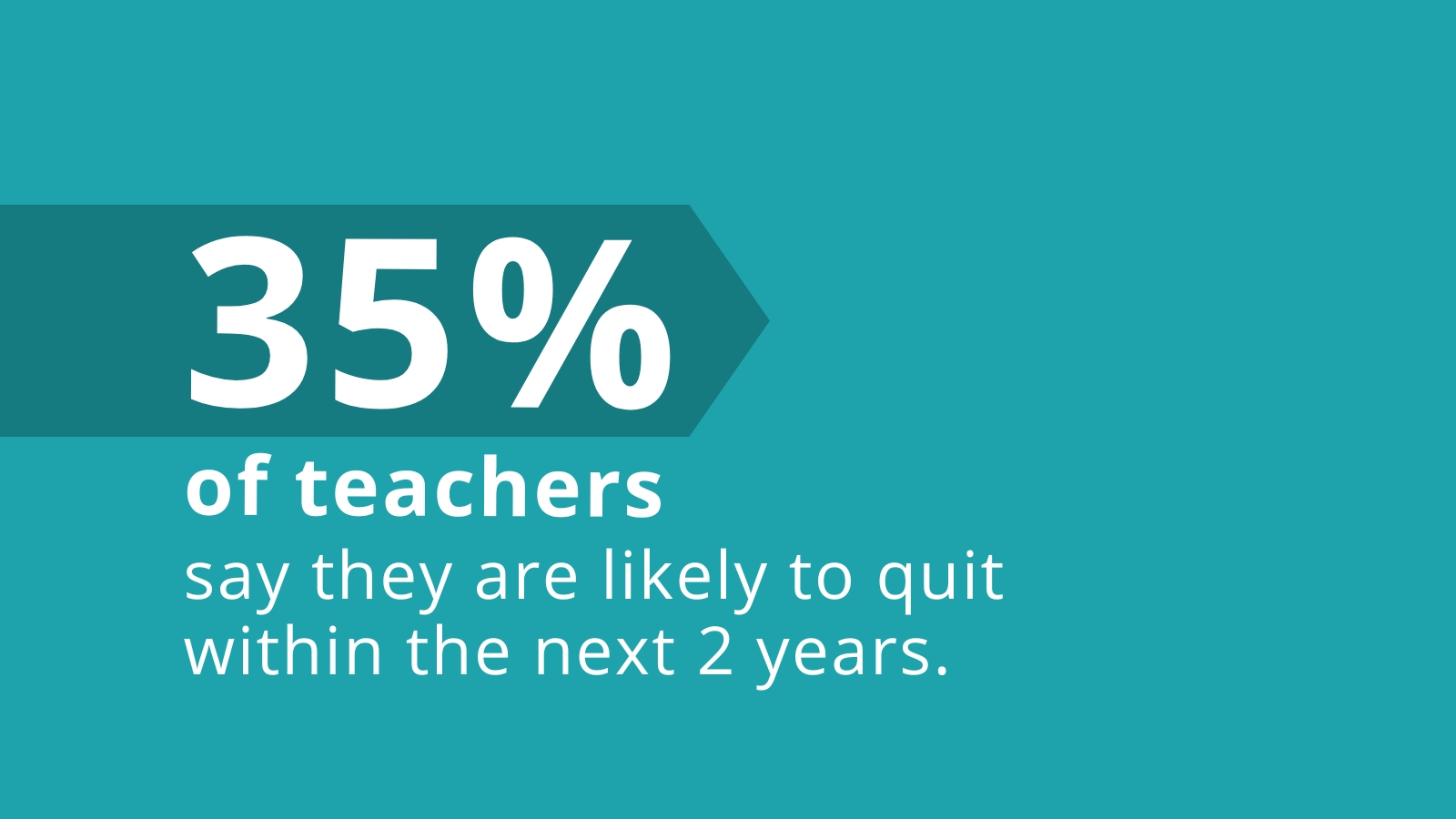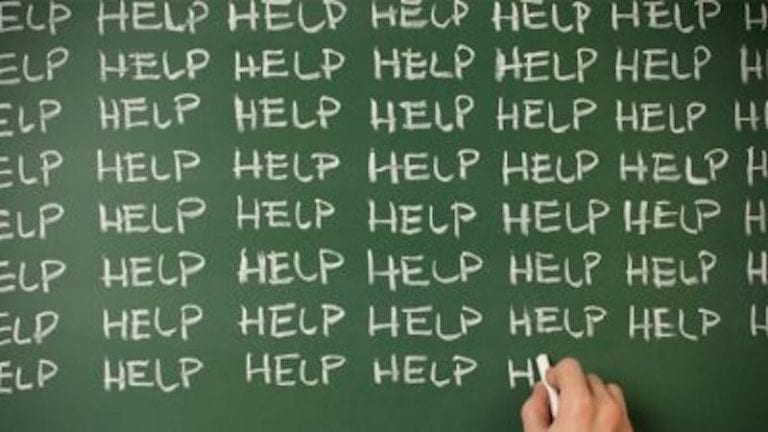Anyone who works in a public school knows that the teaching profession is at a crisis point. Burnout is high, teachers are leaving their jobs at record rates, and the pipeline of new teachers is growing smaller. Below, we’ve gathered 18 of the most alarming 2023 teacher shortage statistics that prove we need to make teaching a more sustainable, desirable job. Plus, one bright spot.
2023 Teacher Shortage Statistics
1. Forty-four percent of teachers are burned out.
In a 2022 Gallup Poll, teaching was the top profession for burnout in the United States. Female teachers reported higher burnout rates than male teachers (55% of female teachers said they were burned out compared to 44% of male teachers). After years of pandemic teaching that’s resulted in taking on more and more work—grading papers at home, covering classes when sub pools run dry, fielding frustrated parents—teachers are feeling the stress. Burnout is preventable though, and teachers have given us insight into what would make their work more sustainable (Hint: It’s salary, among other things).
Source: Research.com
2. Fifty-five percent of educators now indicate that they are ready to leave the profession earlier than planned.
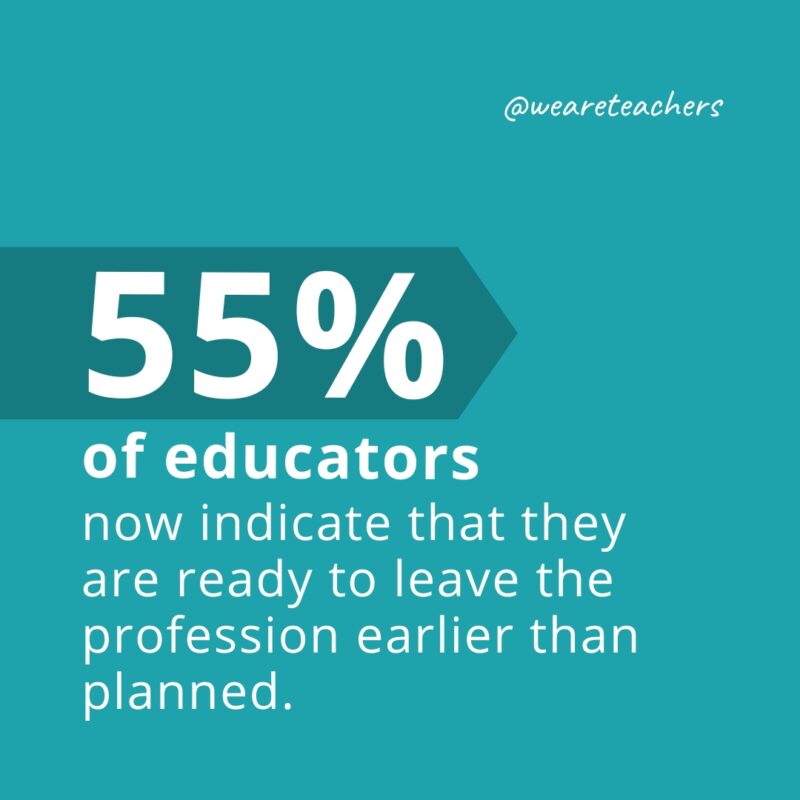
Why are so many teachers who previously considered themselves career educators leaving? It could be the lack of support, the constant work, and struggles with student behavior issues. When schools and districts are losing educators, they need to be reflective in order to make a change and retain the people who will make an impact on their students.
Source: NEA
3. Thirty-five percent of teachers say they are likely to quit within the next 2 years.
If you’re an educator, this sadly isn’t one of the most shocking teacher shortage statistics. In fact, 14% of teachers said they were “very likely” to quit. And this doesn’t just include teachers who are about to retire. It’s teachers who are new to the classroom and are already overwhelmed. And it’s teachers who have given it their all but aren’t getting the support they need. Compare this to 2009, when 17% of teachers said they were planning to leave, and we can see that teachers are reaching a breaking point.
Source: Education Week
4. Eighty percent of educators say that taking on more work due to unfilled job openings within their district is a serious problem.
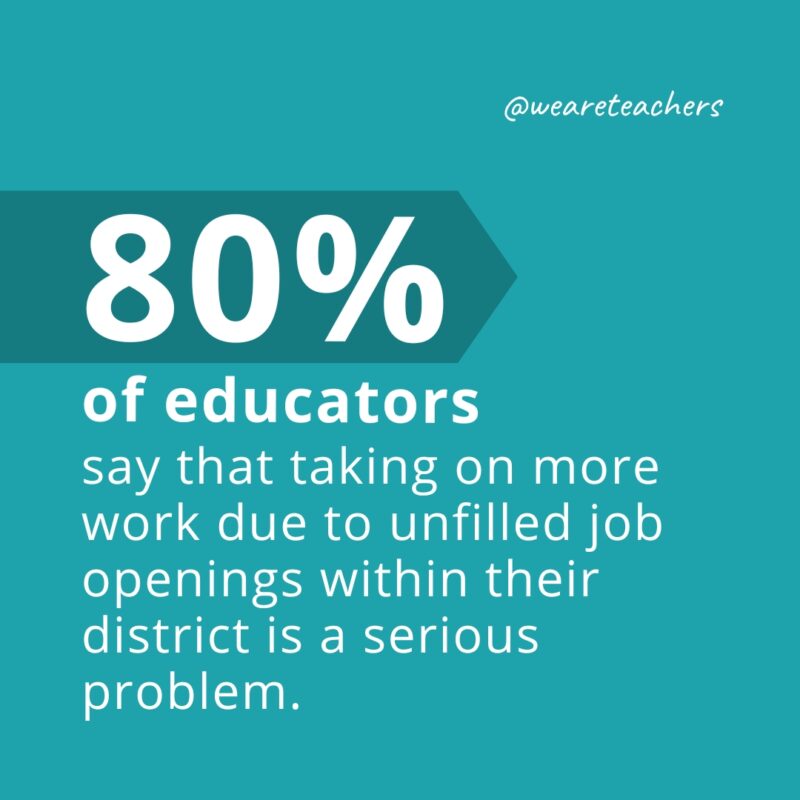
Staff shortages are a problem. Teachers aren’t the only ones leaving education. Custodians, paraprofessionals, and cafeteria workers are also leaving schools. Teachers are picking up the slack in trying to make up for these lost staff members. Even instructional coaches are having to fill in for teachers because there is also a substitute teacher shortage. When buildings are understaffed, educators often aren’t able to do the job they’ve been hired to do.
Source: NEA
5. Only 52% of BIPOC teachers said they were likely to stay in classroom.
This one of the most concerning teacher shortage statistics because we need BIPOC teachers. A diverse teaching workforce is good for teachers as well as students. But BIPOC teachers are split on whether they’re going to stay in the classroom. Fifty-two percent say they will, but that means 48% won’t (and this is higher than the percent of White teachers who say they will leave education). Salary is one part of it, but BIPOC teachers also want more professional development, and support with housing, families, and health care. Those are things that districts can and should provide.
Source: Educators for Excellence
6. Seventy-eight percent of educators say that low pay is a serious issue for teachers.

Can we pay teachers more? It’s no secret that teachers aren’t paid well. What’s interesting about teachers’ salaries, however, is that they vary across the country. And there are even some instances where teachers make less in certain states, but they’re required to do more after contract hours. Furthermore, 78% of teachers said that a higher salary would keep them in teaching—so paying teachers more is a win-win. We need uniformity around teacher salaries across the country, and we also need to value teachers’ time. Let’s give our teachers a wage that they can actually live on comfortably.
Source: Educators for Excellence
Source: NEA
7. Sixty-two percent of teachers want districts to step up with support for discipline.
Teachers know what districts can do to make their jobs more sustainable—support with discipline is their number-one concern. Sixty-two percent of teachers also want smaller class sizes. Other things teachers think districts could do to support teachers: reduce administrative work and meetings, acknowledge teachers’ hard work, and allow teachers to take time off when needed, including for mental health days. (Only 2% of teachers said they couldn’t think of anything their district could do to support them). OK, districts, now it’s your turn.
Source: Education Week
8. Eighty-four percent of teachers spend their own money on basic classroom supplies.
This is a story we’ve heard before. Educators are spending more of their own money on classroom supplies. And the amount they’re spending out of pocket is increasing! Teachers spent $860 on classroom supplies last year, compared to $600 in 2015. Unfortunately, we’re not spending that money on fun extras—84% of teachers spent their own money on basic classroom supplies, and 55% spent it on books. If lawyers and doctors aren’t buying their own highlighters and scalpels, why should we have to buy the basics?
Source: Adopt a Classroom
9. Forty-five percent of teachers say they do not feel respected by the public.
People assume that teachers have summers off to relax, when we’re actually busy with our second jobs. During the year, teachers deal with serious issues like books being banned, lessons being censored, and curriculum being dictated by parents and school boards. Helicopter parents email every day questioning our decisions. It’s no wonder teachers don’t feel respected. And that feeling is on the rise. In 2011, 77% of teachers said their community treated them like professionals, compared to 55% now. It’s time to listen to teachers and rely on their expertise.
Source: Education Week
10. Ninety-two percent of educators endorse hiring more support staff.

We need more support. Not just administrators, but with paraprofessionals, playground aides, and other adults around campus. Support staff don’t only support the teachers, they also support the students. School districts should take a look at their funding and use allocated funds to get support from qualified individuals—not more computer programs.
Source: NEA
11. Eighty-four percent of educators support hiring more counselors and school psychologists.

Most educators support hiring more counselors and school psychologists. Some school districts have laid off counselors during a time when more counselors are needed. Not only do students need more support, but teachers also need the help of counselors to support their students. Hiring more counselors and school psychologists can help to create a more positive school culture. Counselors can visit classrooms, teach lessons about social-emotional awareness, and be one more trusted adult for students to rely on.
Source: NEA
12. Sixty percent of teachers say they don’t have control over their schedules.
Sometimes, the littlest things make the biggest difference. Like being able to choose, for example, morning or afternoon duty. To teach AP English or not. Too often, teachers don’t feel like they have control in key areas of their workday. In an Education Week/Merrimack poll, 67% say they don’t have input in their school’s policies. Sixty percent feel like they don’t have control over their schedule. And 40% of teachers don’t have control over the curriculum they teach. Let teachers have a voice in making district and school decisions and everyone wins.
Source: Education Week
13. Ninety-four percent of educators want more student health and behavioral support.
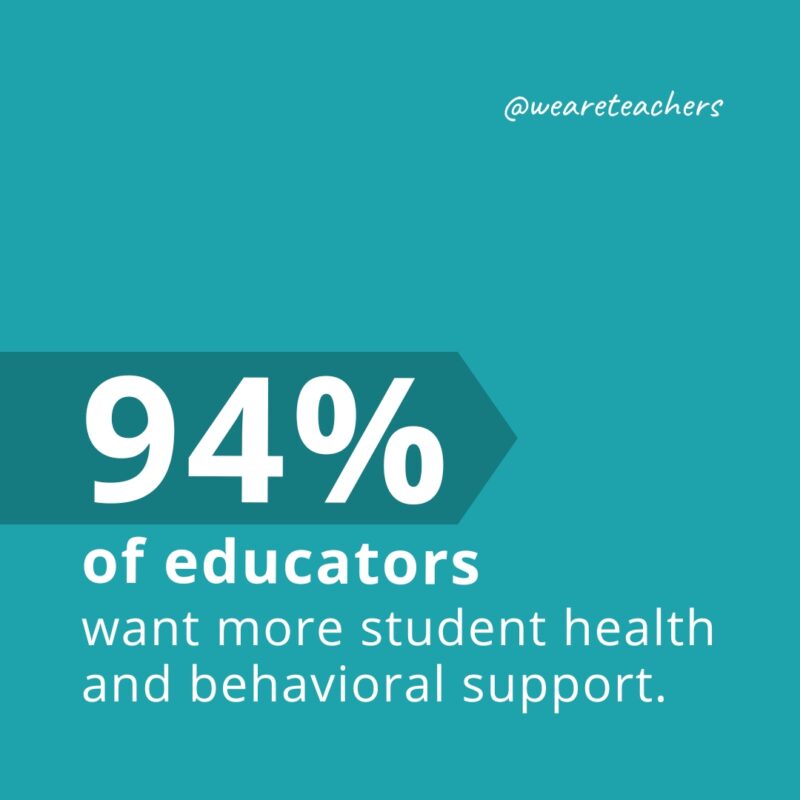
Since we’re seeing so many more challenging student behaviors, it’s evident that students need more health and behavioral support. Students need explicit instruction in how to handle emotions, how to deal with problems in social situations, and so much more. In today’s world, students are coming to school not only to learn academics, but also how to handle their emotions. Supporting students in these areas can help teachers have more productive learning time in their classrooms.
Source: NEA
14. Forty-two percent of teachers said their teaching suffered because of the state of their mental health.
More than half of teachers in the Education Week/Merrimack poll said their mental health and wellness were worse in 2023 compared to previous years. Only 2% of teachers said their district offered supports for mental health and wellness. Some of it does come back to money—67% of teachers said a raise would help alleviate financial stress and improve their mental health.
Source: Education Week
Source: NEA
15. Only 10% of educators would strongly recommend the profession to a young adult.
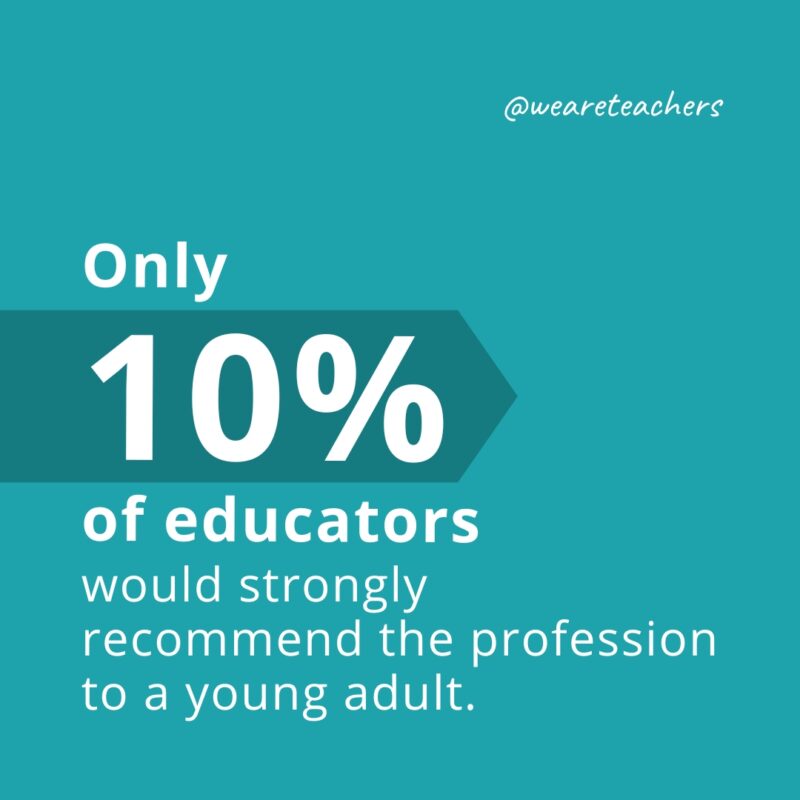
Teachers are so unhappy that they wouldn’t recommend teaching as a profession. How can we get others into a profession if those currently teaching are telling them to stay away? Teachers are warning others that teaching is not an easy profession and that it’s not for everyone. Twenty-two percent of teachers surveyed said another reason they’d warn others to stay away is because the compensation and benefits are not sufficient.
Source: MDR
16. Eighty-six percent of school districts reported difficulty hiring new teachers.
If veteran teachers aren’t recommending teaching, maybe it’s not a surprise that districts are having trouble hiring teachers in 2023 compared to previous years. And only 43% of younger teachers (under age 30) say they’re likely to stay in the classroom for their entire career, the lowest percentage of any age group polled by Education Week/Merrimack. We need to make teaching a career that young teachers want to be a part of.
Source: Educators for Excellence
17. Sixty-five percent of educators agree that bureaucracy interferes with teaching.
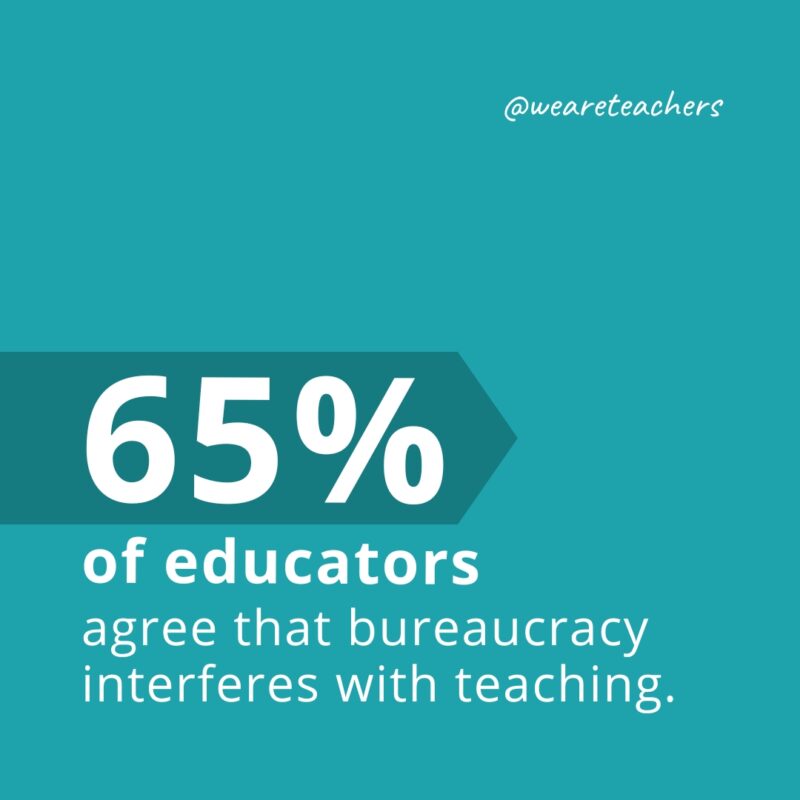
Administration and boards of education are out of touch with what actually happens in a classroom. They don’t know how to teach or how students learn. Teachers feel the enjoyment of learning has been sucked out of education with the need to push curriculum.
Source: MDR
18. Sixty-six percent of teachers are “satisfied” with their job.
Teachers’ hearts are still in it. This is an increase from last year (job satisfaction was up from 56% in an Education Week/Merrimack poll). The percentage of teachers who are “very satisfied” is up 12% from last year. The question, then, is how to keep these teacher shortage statistics on the upswing. How do we keep teachers satisfied in their jobs and improve more teachers’ job satisfaction?
Source: Education Week
One answer may already be in the school building: strong leadership. According to U.S. News & World Report, teachers who have felt supported by their school administration want to stay. Teachers are also staying if they feel they have a voice and are being heard in the decision-making process.
If you found these 2023 teacher shortage statistics interesting and want to learn more about how we can help prevent teacher shortages, read up on creating a positive school culture and giving teachers voice and choice.
For more articles like this, be sure to subscribe to our newsletters.
